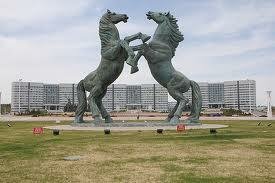China: Ghost Towns
Whether they are the result of speculation gone wild or shrewd planning, China’s ghost towns are spectacular.
Ghost towns are sprouting up in China as a symptom of unbridled speculation, say critics of the Chinese government’s policy of rapid urban expansion near old cities. Analysts estimate there could be as many as a dozen of these gleaming but desolate urban centres scattered about the country. The most well-known one is Kangbashi, south of the city of Ordos on the Mongolian steppes. It has been featured in the New York Times, The Daily Mail, and on websites Al Jazeera and WebUrbanist.
Kangbashi has all the makings of a modern metropolis with a very bright future. It has futuristic architecture, huge reserves of coal and gas, dozens of office buildings and tens of thousands of luxury villas. The one thing it lacks is people.

It was built to house 1 million people but is inhabited by just a few thousand people (despite a government claim of 28,000 residents, who are probably just commuters), claims WebUrbanist.
City leaders had hoped that Kangbashi would be a Chinese version of Dubai, shiny and iconic with great infrastructure. They invested over $1 billion in their project.
But in 2010, four years after the city government was transplanted to Kangbashi, the 31-sq-km area was described as a “monument to excess and misplaced optimism” by the China Daily.
Underpinning all this is China’s national goal of moving 300-500 million people from rural areas to big cities by 2020.
There are other examples in China. In the southern city of Kunming a nearly 103.5-sq-km area called Chenggong has the same deserted roads, high-rises and government offices. And in Tianjin, in the north-east, the city splurged on a huge district covered with golf courses, hot springs and villas that are still empty.
Underpinning all this is China’s national goal of moving 300-500 million people from rural areas to big cities by 2020, in the hope of creating a large middle class.
It is hard to tell if the Ordos-style expansion is caused by unbridled speculation or far-sighted urban planning. Patrick Chovanec, an associate professor of Economics and Management at Tsinghua University in Beijing, said the building boom is driven by frenzied investors – not the housing needs of millions of migrating workers.
“People are using real estate as an investment, as a place to store cash – they treat it like gold,” Professor Chovanec said. “They’re stockpiling empty units. This is going on in cities of virtually every size.”
U.S. blogger Lloyd Lofthouse offered the opposite view. He said that China’s leaders had demonstrated for millennia that China’s collective culture often plans decades and centuries into the future, which explains the success of projects such as the Great Wall and the Grand Canal, which took centuries to complete.
He opined that China’s leaders studied the potential future and planned for it, which is a “benefit of being an autocratic one-party republic instead of a chaotic democracy that depends on short-term goals and quarterly profits to guide the decisions of accountants and lawyers”.
He said that what China is doing by building these empty cities, roads and railways is getting ready for the future.


















